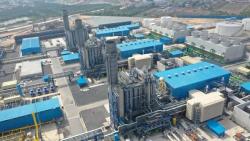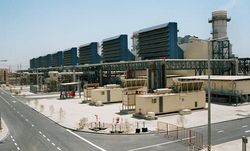
OR WAIT null SECS
© 2024 MJH Life Sciences™ and Turbomachinery Magazine. All rights reserved.
Experience with intake air cooling at Watson Cogeneration Company
Here's a summary of a paper presented by Steve Ingistov, PE, BP/WCC and Mustapha Chaker of Bechtel Corporation about the Watson Cogeneration Company (WCC) plant at the ASME/IGTI conference in 2011. The plant was fully commissioned during the first part of 1988, consists of four GE 7EA gas turbines, two Dresser-Rand Steam Turbines and four dualpressure heat recovery steam generators.
The original installation of the Intake Air (IA) ducting incorporated media-type Evaporative Cooler (EC) system for power boosting which was designed to provide 85% evaporative cooling efficiency for the site rated ambient conditions. The EC media was wetted and the GT inlet air was cooled using the “once-through-water” system.
At the time when WCC plant was designed and commissioned, the EC method for power augmentation was well established. Whereas, the high pressure fogging for power augmentation was in its infancy and very few GT units were furnished and/or retrofitted with the fogging system around the world.
From the very beginning of operation of the GT Units at the WCC plant, it became evident that there was a carry-over of the wet-media cooling water into the compressor. The results of this carry over were significant fouling of the compressor blades and erosion of the first stage compressor’s rotor blades resulting in the loss of GT power output and increase in its heat rate (HR). To mitigate operational and performance issues associated with the EC system, the EC system had to be operated at the part-load until 1998 when a fogging system was installed downstream of the EC system to make-up with the losses of the EC system.
A decision to remove the EC system took several years and was accelerated due to the fact that the water supplying authorities projected curtailment and possibly total cut-off of the waterequired with the once-through-water EC cooling system. Therefore, in 2010 a decision was made to remove the EC system from the GT Unit #4 and rely completely on the fogging system for power augmentation needs.
A power loss associated with the fouling of the EC media, water carryover was happening.
A decision was made to run the all-fog system for the first six months with the EC system readily available, on the stand-by, in case of eventual fog system’s malfunctions and possible side effects which were not anticipated nor predicted with the implemented changes to the GT Unit.
In case the EC system would be necessary, reinstallation of the available EC media would be relatively short and easy and could be made during the weekend.
The fogging system demands high pressure (138 barg) water and also the water must be pure. Demineralized water is most pure and is recommended by the fogging system supplier.
However, the demineralized water can cause corrosion to the carbon steel commonly used in the construction of the IA ducting. While implementing fogging system during 1998 in combination with the existing EC system at the WCC plant and to avoid changing the existing IA ducting, it was decided to use the steam turbine condensate in place of the demineralized water.
Replacement of EC system was also motivated by the fact that the cooling water carry-over into the compressor suction caused some erosion of the compressor R1 blades and also fouled the compressor blades.
Tests in 2010 demonstrated that certain amount of fog particles do not evaporate when expected because of their agglomeration when striking obstruction such as IA silencer panels and the trash screen. The temperatures of fog water have little influence on efficiency of evaporation.
Ambient temperature and humidify have little impact on amount of fog water drained outside the intake air duct.
Removal of 0.30 meters thick EC media introduced extra difficulty when opening IA filter house doors and also introduced possibility of the birds entering IA duct. Trash screens downstream the IA silencer protects GT in such events.
The operator of a seasoned power plant should not place the fog manifold upstream the IAS which is typically dirty and covered with layer of smudge.
Place for manifold upstream the silencer, minimum one meter distance, when the silencer is new. Distribute fog-generating nozzles in such a way that they face the space between the silencer panels.
Place the trash screen upstream as far as practical and safe from the compressor suction. Avoid usage of de-mineralized water in case the IA duct is made from carbon steel.



